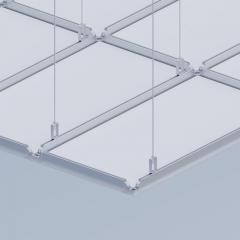
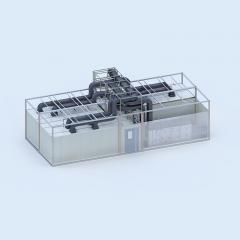
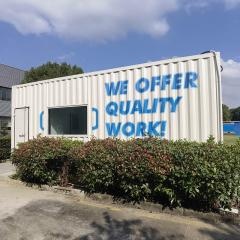
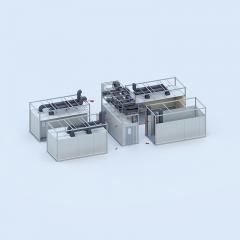
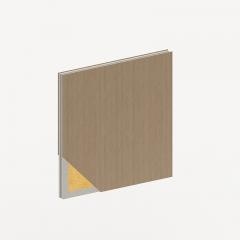
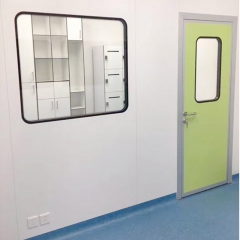
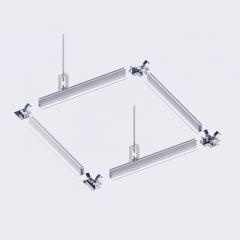
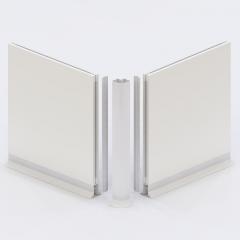
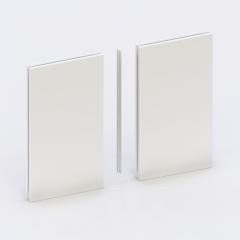
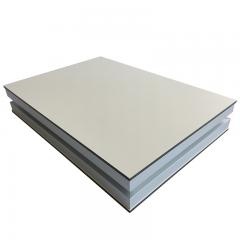
In the field of modern technological manufacturing, clean rooms (clean) are widely used to ensure the high quality and purity of products and experiments. The wall system of the clean room is an important part of building an efficient and clean environment. This article will introduce clean room wall systems and focus on the keywords: cleanroom wall panels, clean room partitions, clean room sandwich panel, cleanroom panel manufacturer and mobile container laboratory design. Clean room wall systems bear the key task of maintaining a clean environment. cleanroom wall panels are ideal for constructing cleanroom walls. Carefully designed and manufactured by professional manufacturers, these wall panels offer excellent performance and excellent durability. They are made from high-quality materials and combined with advanced manufacturing technology to ensure clean room reliability and stability. These wall panels have a flat, smooth and easy-to-clean surface that effectively resists the intrusion of dust, contaminants and microorganisms. Clean room partitions are the dividing elements of the interior space of a clean room. They divide the clean room area into different work areas and control areas according to different needs and functions. These partitions not only provide excellent isolation properties but also provide good sound and light control. Through precise design and engineering, manufacturers ensure that these zoning systems work perfectly with the other components of the clean room to achieve optimal performance of the environment inside the clean room. clean room sandwich panelis a wall material with excellent thermal and acoustic insulation properties. The sandwich wall panels are constructed from multiple layers of materials, including a high-density polyurethane foam core and two layers of metal panels, both inside and out. This structure not only helps effectively isolate outside noise and temperature changes, but also provides long-lasting durability and strong structural stability. Cleanroom panel manufacturer uses advanced technology and production processes to produce high-quality sandwich wall panels to meet the needs of various clean environments. The mobile container laboratory is an innovative design that combines clean room technology with a laboratory environment. This design allows the laboratory to be quickly deployed where needed and has the cleanliness and control requirements of a clean room. These mobile container laboratories offer highly customizable options to meet the needs of different types of experiments and research projects. Its structure and equipment design comply with strict clean environment standards and can be adapted according to experimental requirements. In the world of clean technology, the choice of a cleanroom wall system is a decision about quality and success. From cleanroom wall panels to clean room partitions, from clean room sandwich panels to cleanroom panel manufacturers, to mobile container...
Clean room equipment plays a crucial role in maintaining the quality and of controlled environments. Among the various equipment used, air showers, pass boxes, air shower designs, clean room weighing covers, and clean laminar flow hoods are of significant importance. These pieces of equipment ensure the cleanliness and sterility necessary for sensitive operations. Air showers are essential components of clean room entrances. They are designed to remove particulate contamination from personnel entering or exiting the clean room. By directing high-velocity filtered air onto individuals, air showers effectively eliminate dust, debris, and other impurities that may compromise the controlled environment. Pass boxes provide a controlled transfer mechanism for materials between different cleanliness zones within a clean room. They are particularly useful in preventing cross-contamination. With a unique dual-door design, pass boxes minimize air exchange and maintain the integrity of the controlled environment. The design of air showers is of utmost importance in optimizing their functionality. Efficient air shower designs involve careful consideration of airflow patterns, nozzle placements, and air velocity. By ensuring thorough and uniform cleansing of personnel, these designs contribute to improved cleanliness levels within the clean room. Clean room weighing covers are specifically designed to shield weighing equipment from external contaminants. They provide an additional layer of protection to sensitive measurements, preventing any foreign particles from interfering with the accuracy of the weighing process. Clean room weighing covers are designed to fit securely over the weighing apparatus, minimizing the risk of contamination. Clean laminar flow hoods are employed in clean room settings to provide an ultra-clean work environment. These hoods use high-efficiency particulate air (HEPA) filters, ensuring that the air passing through them is free from airborne contaminants. Clean laminar flow hoods create a controlled laminar airflow, which envelops the work area, protecting sensitive materials and processes from contamination. To acquire quality clean room equipment, it is essential to collaborate with reputable clean room doors manufacturers, sealing clean room door providers, and clean room doors suppliers. These industry experts offer a wide range of products that meet stringent cleanliness standards and regulatory requirements. Their expertise and experience ensure the reliability and efficiency of clean room equipment, contributing to the overall success of clean room operations. In summary, clean room equipment such as air showers, pass boxes, air shower designs, clean room weighing covers, and clean laminar flow hoods are critical elements in maintaining the cleanliness and sterility of controlled environments. By implementing these equipment solutions and partnering with reliable manufacturers and suppliers, businesses can ensure the integrit...
Clean Room HPL Doors: Taking care of the clean details In modern industry and science, clean room doors play a vital role in ensuring work efficiency and quality in highly clean environments. Among the many clean room doors, High-Pressure Laminate (HPL) doors have become the industry leader with their excellent performance and elegant appearance. This article will focus on the characteristics of HPL doors, related manufacturers and suppliers, and highlight their advantages in sealing clean room doors. As a door type designed specifically for clean environments, clean room doors serve several important functions. First, they must be able to effectively isolate the clean room from the external environment to ensure that no harmful substances can enter the clean area. In addition, clean room doors need to meet strict cleanliness standards to prevent microorganisms, dust and particles from entering the work area. In this context, HPL doors for clean rooms stand out, combining practicality with elegance. In order to meet different clean room needs, many professional manufacturers are committed to producing and supplying clean room door products. With the help of advanced technology and materials, these clean room door manufacturers continuously improve the quality and performance of their products to meet the diverse needs of their customers. Their product portfolio includes HPL doors in a variety of sizes, materials and designs, ensuring clean room projects of varying sizes and requirements can be catered for. Sealing clean room doors is a critical factor that cannot be ignored when choosing a clean room door supplier. A good sealing system can effectively block the exchange between the clean room and the external environment, ensuring the stability of cleanliness and air quality. Clean room HPL doors are popular for their excellent sealing properties and fully meet the stringent clean room requirements. This supplier of sealed clean room doors offers reliable and proven solutions to the clean room industry. To summarize, clean room doors are crucial in providing a clean working environment. As one of the most popular and reliable options, clean room HPL doors are the first choice for all types of clean room projects due to their superior performance and elegant appearance. Choose a reliable clean room HPL door manufacturer and supplier to ensure you get high-quality products that meet clean environment requirements and enjoy the huge benefits of a clean working environment.
In recent years, with the continuous development of science and technology, more and more laboratories and testing sites require efficient and reliable modular clean room solutions. As a professional modular clean room manufacturer, we are committed to providing our customers with the most advanced technology and quality products. Below are some keywords and what they represent. First of all, we have rich experience and expertise and are a well-known modular clean room manufacturer. Our product range includes modular laboratory buildings, container laboratories, and modular clean rooms designed for testing laboratories. These solutions meet the needs of a variety of different industries and sectors, including pharmaceuticals, biotechnology, electronics manufacturing, and more. Secondly, the modular cleanrooms we offer are of exceptional quality and performance. We use stainless steel to manufacture clean room doors, ensuring they have good corrosion resistance and durability. We also offer sliding doors for efficient use in tight spaces. In addition, our laboratory doors also feature emergency door locks to ensure they can be opened quickly in an emergency. When it comes to design, we focus on customizing the best clean room door solutions for our customers. Our design team will provide the most appropriate door size and installation, taking into account the customer's specific needs and space constraints. We also pay attention to detail to ensure that the clean room doors harmonize with the overall laboratory environment while providing an elegant and modern appearance. Finally, we also offer automatic door solutions to increase laboratory productivity and convenience. Automatic doors can automatically open or close based on signals from sensors or buttons, reducing manual intervention and ensuring the stability of the clean room environment. In summary, as a modular cleanroom manufacturer, we are committed to providing our customers with high-quality, reliable solutions. Our products include modular laboratory buildings, container laboratories, and modular clean rooms designed for testing laboratories. Our clean room doors are manufactured from stainless steel for corrosion resistance and durability. We offer sliding door and emergency door locking capabilities, as well as custom designs and automatic door solutions. We are always committed to meeting the needs of our customers and providing them with the best products and services.
Clean Room Doors: Focus on Quality and Advanced Design Clean room doors are a key component in maintaining a clean environment from outside contamination. As part of a clean room system, they play an important role in ensuring the highest standards of cleanliness and operational efficiency. Today, there are many excellent clean room door manufacturers offering a variety of door styles to meet the needs of various industries and applications. Stainless steel clean room doors are one of the most popular types on the market today. This kind of door has excellent anti-corrosion properties and long-term durability, and is suitable for various clean environments. The manufacturer uses high-quality stainless steel materials in the design and manufacturing process to ensure the door's sturdiness and protective properties to meet strict hygiene and cleanliness requirements. Sliding doors are also an option widely used in clean rooms. Its unique sliding design saves space and provides easier entry and exit. This type of door typically features advanced automation systems that ensure smooth operation and reliability while providing superior cleanliness and sealing. Laboratory door manufacturers specialize in designing high-quality doors for research and laboratory environments. These doors are engineered to meet the needs of laboratory workflows while providing excellent sealing and cleanliness. Manufacturers invest a lot of effort in material selection, structural design and process manufacturing to ensure efficient operation and reliability of laboratory doors in various environments. In emergency situations, interactive doors with emergency access become crucial. The emergency opening and closing functions and the design of the emergency passage enable this type of door to quickly isolate the clean room in an emergency, ensuring the safety of personnel. Manufacturers provide trusted emergency door solutions by combining innovative technology with reliable build quality. The design of clean room doors is also increasingly focusing on combining aesthetics and functionality. Manufacturers not only provide doors that meet cleanliness requirements, but also pay attention to the appearance and overall design of the door. By combining the elegant look of the material with modern design elements, clean room doors not only meet practical needs but also add a touch of sophistication and class to a clean environment. In conclusion, clean room door manufacturers strive to provide door styles with superior quality, reliability and innovative designs. Whether they are stainless steel clean room doors, sliding doors or doors with emergency functions, they all play an important role in a variety of environments. Whether it's a laboratory or a clean room, these doors are a critical element in maintaining cleanliness, increasing productivity and ensuring safety.
In modern science and technology, sterile and clean environments are crucial for laboratory and industrial production. To ensure these environments are highly clean and dust-free, a key element is the cleanroom ceiling grid system. The clean room ceiling grid is made of aluminum alloy and adopts advanced design and technology to meet strict cleanliness requirements. Aluminum ceilings offer excellent performance and durability. They effectively resist corrosion and oxidation and are lightweight and strong, making them ideal for use in cleanroom environments. The clean room ceiling grid adopts a T-slot design, often called "T-slot", which provides a stable support structure and convenient installation. Bottom-loaded ceiling grids are a common design that is characterized by ease of installation and maintenance. It consists of primary T-beams and secondary cross-beams that are capable of carrying a variety of cleanroom ceiling panels and other accessories. This design also provides easy access, making replacement and repair of ceiling panels quick and easy. Cleanroom ceiling grids also have other important features, such as excellent sealing and sound insulation. They effectively control air flow and sound transmission, ensuring quiet and comfortable laboratory and production environments. Clean room false ceiling is an important part of the clean room ceiling grid. They come in a variety of panel materials such as polyurethane sandwich panels or other suitable materials to provide a clean, easy-to-clean and anti-microbial surface. These panels are typically flat, dust-free and static-free, meeting strict cleanliness standards. When it comes to clean room ceiling grids and decorative panels, there are many professional clean room ceiling suppliers and clean room panel manufacturers offering a variety of products and solutions. Clean room ceiling suppliers are able to provide customized design and installation services based on the customer's specific needs and cleanliness levels. In summary, clean room ceiling grids are an important component in ensuring clean and dust-free laboratory and industrial production environments. These premium ceiling systems are constructed from aluminum alloy using advanced design and craftsmanship, combined with a variety of panel materials to provide a clean, easy to install and maintain solution. When selecting cleanroom ceilings and panels, working with professional cleanroom ceiling suppliers and manufacturers ensures compliance with cleanroom requirements and an optimal laboratory environment.